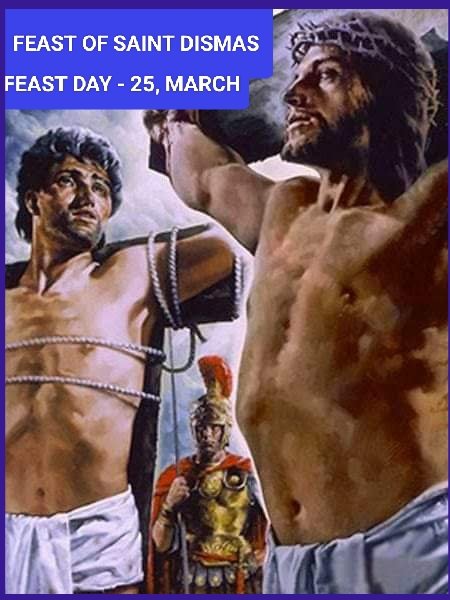
John 12:7-8
March 25, 2024
MONTHLY DEVOTIONAL FOR 25th MARCH
March 25, 2024FEAST OF SAINT DISMAS – 25 MARCH

Saint Dismas was one of the two thieves crucified with Jesus, who was canonized by our Lord himself when he was told, “This day, you will be with me in Paradise.” (Lk. 23:43) As Venerable Archbishop Fulton J. Sheen (1895-1979) remarked in one of his homilies, “He was a thief to the end and he even stole heaven!”
Not many historical facts are known about his life, but there are several legends that have come to us throughout the generations. The “good thief,” also known as the penitent thief, is one of two unnamed thieves in St. Luke’s account of the crucifixion of Jesus in the New Testament. The Gospel of Luke describes him asking Jesus to “remember him” when Jesus arrives at His kingdom. The other, as the unrepentant thief, challenges Jesus to save Himself and both of them to prove that He is the Messiah.
He is officially venerated as a saint in the Catholic Church. The Roman Martyrology places his commemoration on March 25, on the feast of the Annunciation, because of the ancient Christian tradition that Christ as well as the penitent thief were crucified and died exactly on the anniversary of Christ’s Incarnation. He is given the name Dismas in the Gospel of Nicodemus and is traditionally known as St. Dismas . The traditional name for the unrepentant thief is Gesmas.
These two men were crucified at the same time as Jesus, one on his right and one on his left, which the Gospel of Mark interprets as fulfillment of the prophecy of Isaiah: “And he was numbered with the transgressors.” (Is. 53:12) According to both the Gospels of St. Matthew and St. Mark, both of the thieves mocked Jesus; however, St. Luke related: “Now one of the criminals hanging there reviled Jesus, saying, ‘Are you not the Messiah? Save yourself and us.’

The other, however, rebuking him, said in reply, ‘Have you no fear of God, for you are subject to the same condemnation? And indeed, we have been condemned justly for the sentence we received corresponds to our crimes, but this man has done nothing criminal.’ Then he said, ‘Jesus, remember me, when you come into your kingdom.’ He replied to him, ‘Amen, I say to you, today you will be with me in Paradise.’” (Lk. 23:39-43)
According to tradition, the good thief was crucified to the right of Jesus and the other thief was crucified to His left. For this reason, depictions of the crucifixion of Jesus often show our Lord’s head inclined to His right, showing His acceptance of the good thief. In the Russian Orthodox Church, both crucifixes and crosses are usually made with three bars: the top one, representing the titulus, which is the inscription that Pontius Pilate wrote and was nailed above the head of Jesus; the longer crossbar on which His hands were nailed; and a slanted bar at the bottom representing the footrest to which His feet were nailed. The footrest is slanted, pointing up towards the good thief, and pointing down towards the other.
German mystic Blessed Ann Catherine Emmerich (1774-1824), who was beatified in 2004, wrote in chapter 40 of her book The Dolorous Passion of Our Lord Jesus Christ a touching account of a much earlier encounter with our Lord and Dismas. It relates that the families of Dismas and Gesmas were both from bands of frontier robbers on the border of Israel and Egypt.
The Holy Family was exhausted and when they took refuge in a cave there, it was the mother of Dismas who granted hospitality to them. Her son, Dismas had been a leprous child and he was instantly cleansed by being dipped in the water, which was used to bathe the Infant Jesus. The charity of the mother of Dismas was rewarded by the cure of her child.

This outward purification was symbolic of the inward purification that was afterwards accomplished in the soul of Dismas at Calvary, through the sacred Blood that was shed on the cross for him. Although Dismas knew nothing about Jesus, his heart was not hardened and the sight of the extreme patience of our Lord very much moved him.
In medieval art, St. Dismas is often depicted as accompanying Jesus in the descent into hell as related in 1 Peter 3:19–20 and the Apostles’ Creed, although neither of those texts mention the thief. In the Eastern Orthodox Church, one of the hymns of Good Friday is entitled The Good Thief and speaks of how Christ granted paradise to Dismas. He is patron saint of prisoners and thieves.
PRAYER
Saint Dismas, you alone were Canonized a Saint by Christ Himself; you were assured of a place in Heaven with Him, “This day” because you confessed your sins to Him on Calvary; and you were truly sorry for them as you hung beside Him on a cross.
It was you, who opened the Heart of Jesus in mercy and forgiveness even before the centurion’s spear tore it asunder; you whose face was close to that of Jesus in His last agony, to offer Him a word of comfort; you who knew how to pray, teach me the words to say to gain pardon for my sins; and you who are close to Him now in Heaven, pray to Him for me that I shall never again desert Him, but that at the close of my life I may hear the words He addressed to you: “This day thou shalt be with Me in Paradise.” Amen.





